Starliner: Boeing's next-generation spaceship for astronauts
Starliner is the commercial spacecraft Boeing will use to carry astronauts to space.
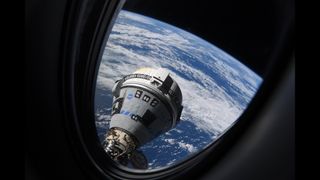
Boeing's Starliner spacecraft is one of two systems aiming to bring NASA astronauts to space.
The CST-100 Starliner has completed two uncrewed flights so far: one that failed to reach the International Space Station (ISS) as planned in 2019, and another that met all of its major objectives in 2022.
When is the next Starliner launch?
The first crewed Starliner test mission is slated for no earlier than May 6, 2024.
During the first crewed test flight, two astronauts — NASA's Suni Williams and Butch Wilmore — will fly on Starliner's 10-day Crew Flight Test mission, or CFT, to the International Space Station (ISS). If all goes according to plan, at least three astronauts will venture to the ISS for the operational six-month Starliner-1 flight in 2025.
Meanwhile, missions to the ISS are run by SpaceX's Crew Dragon, which was certified for flight in 2020. Both SpaceX and Boeing are recipients of NASA Commercial Crew Program (CCP) funding first announced in 2014.
They were tasked with developing spacecraft to ferry astronauts to the ISS. Initial NASA estimates for the program suggested the spacecraft would be ready in 2017, but funding and development challenges pushed that timeline back by several years.
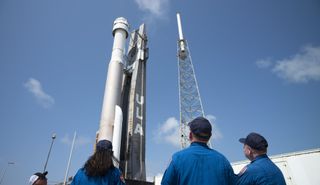
Starliner is similar in shape to the spacecraft from NASA's Apollo program, but this new, commercial spacecraft has electronics that are half a century more advanced. Measuring 14.8 feet (4.5 meters) across at its widest point, the gumdrop-shaped spacecraft will first fly into space aboard Atlas V rockets.
The spacecraft is designed to carry up to seven astronauts, with additional cargo also possible if fewer astronauts fly during a particular mission.
Starliner FAQs answered by an expert
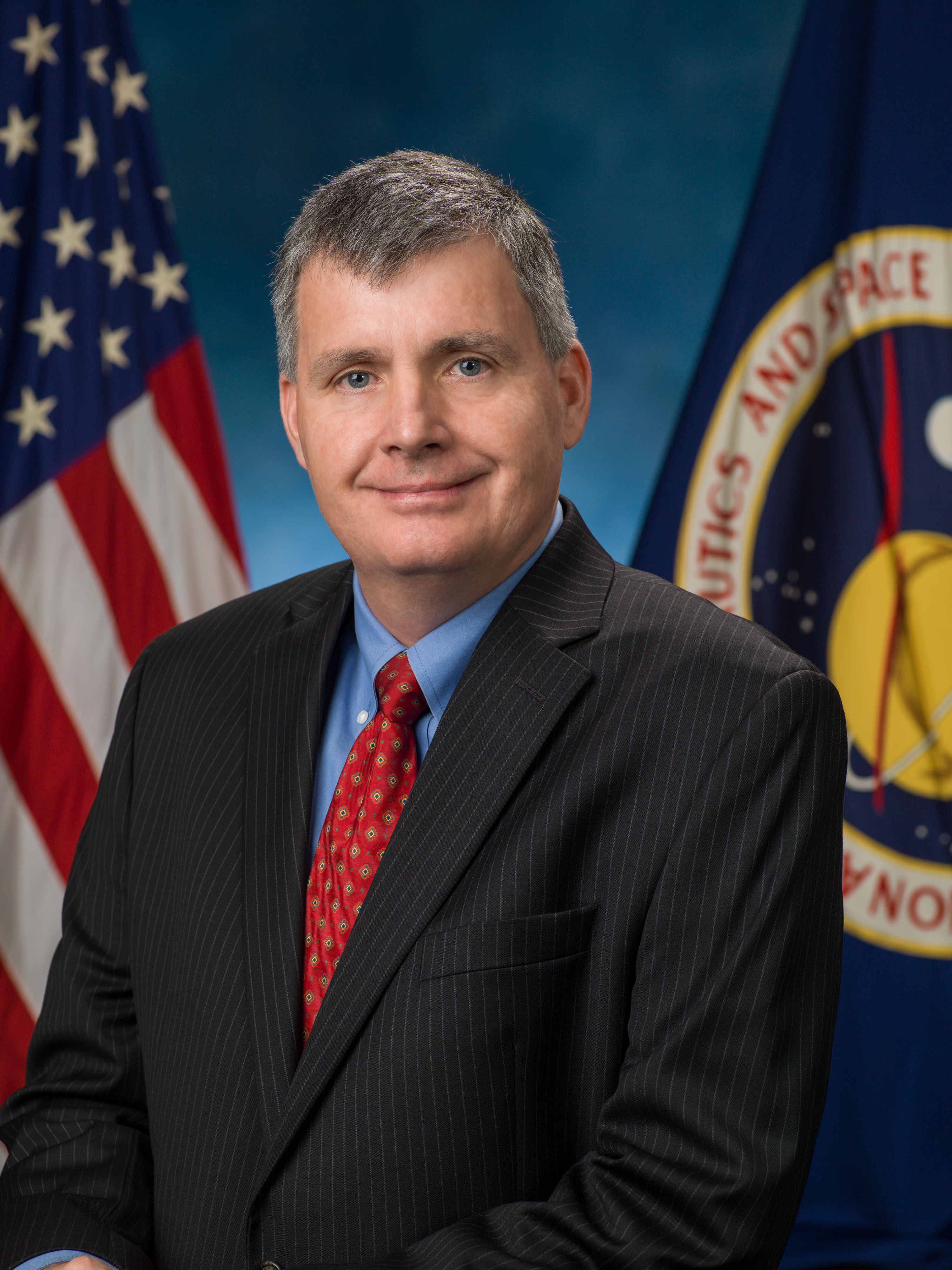
Steve Stich is program manager for NASA's Commercial Crew Program and is responsible for commercial spacecraft development and certification for U.S. companies to carry astronauts to the International Space Station. He joined NASA in 1987 and has held positions such as deputy manager of NASA's Commercial Crew Program and director of the Exploration Integration and Science Directorate.
What is flapping on Starliner during launches?
Stich: The thrusters themselves have thruster covers on them, and they're really rain covers. They're really needed for the ground. So we put this paper over them; butcher paper is what it's called. It's like a plastic, so that it protects any rain from going inside the thrusters when we're outside. They blow off normally when the thruster fires, and sometimes they blow off during ascent ... so they tore off [during OFT-2], but they're designed to do that, and it's perfectly normal.
Is Boeing ready for future flights?
Stich: We have a lot of redundancy that really didn't affect a lot of operations at all. … I know after the [OFT-2] flight, we'll go study any failures there and see what happened.
How does NASA feel about Boeing's team?
Stich: I want to thank the entire NASA and Boeing team. A lot of resilience was demonstrated over the last few years, and really the last 10 months [before OFT-2] of getting their flight ready. The Starliner has performed beautifully. It's a great crew transportation system.
Stich's comments were delivered May 20, 2022, during a news conference that Space.com attended. The questions were adapted for publication.
What spacesuits do Boeing astronauts wear
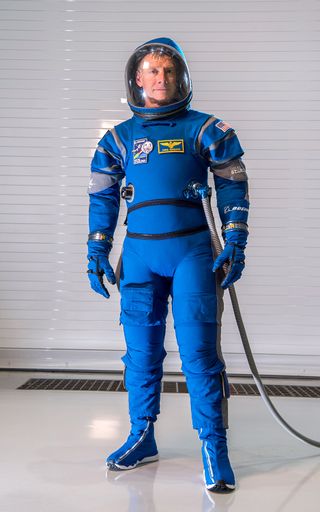
In 2017, Boeing unveiled the spacesuit that astronauts will wear aboard Starliner. The bright-blue suit stands out against NASA's classic suits and SpaceX's black-and-white suits and features several advancements over previous spacesuit designs.
The Boeing spacesuit is smaller and lighter, and includes "innovative layers" designed to keep astronauts cooler, according to a description on the Boeing website. Zippers on the torso are placed for easier movements between sitting and standing, and the helmet has a wide-view visor for good peripheral vision. The spacesuit also includes special gloves designed to allow astronauts to use touchpad screens, a feature shared with SpaceX's spacesuits.
How is Starliner supported by NASA's Commercial Crew Program
Funding for the development and building of the CST-100 Starliner spacecraft came primarily from Boeing's partnership with NASA's CCP. Boeing and SpaceX received several previous grants under NASA's commercial crew development program.
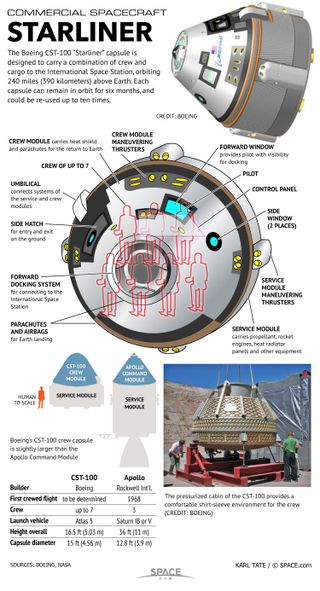
The program funded and examined several companies for years and, in 2014, selected Boeing and SpaceX for launching astronauts. NASA used to fly most astronauts with its space shuttle and chose commercial partners for the next generation of spacecraft after the shuttle program was retired in 2011 following 30 years of service. The agency leaned upon the Russian Soyuz spacecraft in the meantime to launch NASA astronauts, paying millions of dollars per seat until its selected providers were ready.
As of May 2020, under the CCP, NASA had given SpaceX about $3.1 billion to develop its Crew Dragon spacecraft and Boeing about $4.8 billion to develop Starliner. NASA plans to run the ISS until 2030, if all partners agree, and for transportation, it has allocated 14 crewed missions to SpaceX as of June 1, 2022, and six to Boeing.
What testing did Starliner go through
Boeing had been testing Starliner, preparing for its first crewed flight to space, for many years, even before its first flight, Orbital Flight Test 1 (OFT-1), in 2019.
In 2011, the company put a 12- by 14-inch (30 by 36 centimeters) model of the CST-100 in a wind tunnel to determine the spacecraft's aerodynamic characteristics. The model was placed in several positions to simulate different phases of an abort-mode landing.
In 2012, Boeing did parachute drop tests of the CST-100 to determine how well the spacecraft's parachutes and airbags worked. Unlike the Apollo missions, Starliner will touch down on land, making the airbags especially important for a smooth and safe landing.
In 2014, Boeing officially unveiled a full-scale mock-up of the CST-100 at Kennedy Space Center, showing the inside of the spacecraft for the first time publicly. Airbag testing of the spacecraft proceeded successfully in February 2016, and in March 2017, it underwent a successful parachute test in the New Mexico desert.
Boeing conducted an abort engine test in June 2018, but issues during the test pushed the first test flight for Starliner to 2019.
When did Starliner first fly
On Dec. 20, 2019, Starliner launched to space for the first time as part of the craft's Orbital Flight Test 1 mission, an uncrewed test flight to the International Space Station where it would dock and orbit Earth for about two days.
The spacecraft took off atop a United Launch Alliance Atlas V rocket from Cape Canaveral, Florida, at 6:36 a.m. EST (1136 GMT) as planned. However, 90 minutes after takeoff, then-NASA Administrator Jim Bridenstine announced that the capsule would not reach the space station as intended.
"Today, a lot of things went right, and this is in fact why we test," Bridenstine said at the time. "If we would have had [a] crew in there, number one, they would have been safe."
That said, the capsule did not get to the space station because it did not reach its expected orbit. The capsule's internal clock that helps to control timed events during the launch sequence had an error, so the capsule burned too much fuel to safely dock with the space station.
Instead, the teams at Boeing had the capsule land in New Mexico and use airbags to make a soft touchdown on land, which was a critical testing item.
In July 2020, a joint NASA-Boeing independent review team completed a lengthy and detailed review of the test flight, identifying 61 "corrective actions" for Boeing to address with Starliner. On July 7, 2020, NASA announced that, after a second review, the number of actions had actually grown to 80 total corrective actions for Boeing.
According to a statement from NASA, these actions included 21 recommendations regarding testing and simulation for the craft, including better testing for software and hardware; 10 recommendations covering software requirements; 35 recommendations regarding modifications to processes and operations, like test data reviews, peer reviews and increasing involvement of subject matter experts; seven recommendations about software updates and changes; and seven recommendations regarding knowledge capture and hardware modification, including organizational recommendations for changing the safety reporting structure.
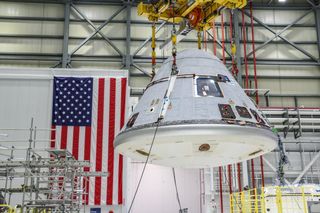
Starliner's second test flight
With 80 corrective actions needing to be addressed following the first test flight, Boeing planned to launch a second uncrewed test flight before it began launching crews to space. To prepare for the flight, NASA and Boeing first resolved all of the corrective actions recommended by the NASA-Boeing independent review team.
This second uncrewed test mission, dubbed Orbital Flight Test 2 (OFT-2), was additionally delayed a number of times due to factors such as weather and technical problems, and finally resulted in a successful launch on May 19, 2022. The biggest set of delays came in August 2021, after technicians conducting routine prelaunch checks found that more than a dozen valves in Starliner's propulsion system were stuck. Months of technical work were required to fix this issue before the spacecraft was ready for launch.
Starliner lifted off safely from Space Launch Complex 41 at Cape Canaveral Space Force Station in Florida on May 19, 2022. It then docked with the ISS as planned on May 21, 2022, allowing the crew to swap supplies and equipment, and landed at White Sands Missile Range in New Mexico on May 25, 2022. These three major mission items of launch, docking and landing allowed NASA to later move ahead with certifying the system for a test human spaceflight.
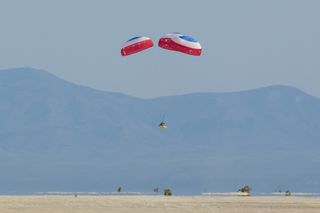
No people were on board OFT-2, but it did carry a test flight dummy called Rosie the Rocketeer. (Rosie also flew on OFT-1, measuring stresses on the flight via sensors, but flew unequipped on the second flight as ballast.) Otherwise, Starliner ferried more than 500 pounds (225 kilograms) to the International Space Station, and the spacecraft came back to Earth with more than 600 pounds (272 kg) of cargo.
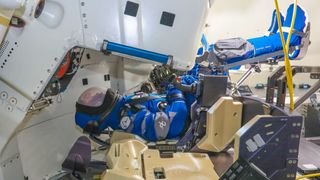
Commemorative items also flew to space aboard OFT-2, including 14 banners from historically Black colleges and universities, Silver Snoopy pins (traditionally given to NASA astronauts who directly contribute to human spaceflight success) and Rosie the Riveter commemorative coins to honor the nearly 19 million American women who assisted the aerospace industry during World War II.
When will Starliner fly with astronauts?
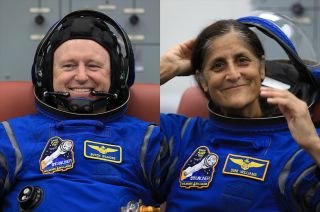
The latest target for Starliner's first launch with astronauts is no earlier than May 6, 2024.
NASA astronauts Barry "Butch" Wilmore and Sunita Williams are slated to fly aboard this test mission, which is called Crew Flight Test. Its major objective is to launch to the space station, dock and return to Earth, replicating OFT-2's milestones with a crew on board. The mission will last nine or 10 days, a fraction of a typical ISS half-year mission but enough to certify the system. If all goes well, Starliner will be fully certified for carrying astronaut crews.
"Starliner's two uncrewed orbital flight tests provided invaluable information about our spacecraft," Mark Nappi, vice president and program manager for the Starliner program, said in a Nov. 3, 2022, Boeing statement. "Additional learnings are expected as Starliner transitions from a fully autonomous flight without crew to flights with crew. With the help of experienced NASA test pilots, Wilmore and Williams, we are closer to our goal of flying a safe and capable spacecraft."
Additional resources
Read more about Starliner on Boeing's webpage about the spacecraft. Follow updates on Starliner on this dedicated Boeing page. Watch 90 minutes of OFT-2 launch coverage on NASA's YouTube channel.
References
Boeing. (2022). Starliner. https://www.boeing.com/space/starliner/
Boeing. (2022, November 3). NASA, Boeing adjust Starliner Crew Flight Test launch date. https://starlinerupdates.com/nasa-boeing-adjust-starliner-crew-flight-test-launch-date/
Boeing. (2023). Starliner updates. https://starlinerupdates.com/
NASA. (2022, June 1). NASA to purchase additional cCommercial crew missions. https://blogs.nasa.gov/kennedy/2022/06/01/nasa-to-purchase-additional-commercial-crew-missions/
NASA. (n.d.). Starliner. Retrieved February 3, 2023, from https://www.nasa.gov/subject/11845/starliner/
Boeing. (2017, Jan. 25). Suit Up. https://www.boeing.com/features/2017/01/space-suit-01-17.page
Follow us on Twitter @Spacedotcom and on Facebook.
Join our Space Forums to keep talking space on the latest missions, night sky and more! And if you have a news tip, correction or comment, let us know at: community@space.com.
Get the Space.com Newsletter
Breaking space news, the latest updates on rocket launches, skywatching events and more!

Chelsea “Foxanne” Gohd joined Space.com in 2018 and is now a Senior Writer, writing about everything from climate change to planetary science and human spaceflight in both articles and on-camera in videos. With a degree in Public Health and biological sciences, Chelsea has written and worked for institutions including the American Museum of Natural History, Scientific American, Discover Magazine Blog, Astronomy Magazine and Live Science. When not writing, editing or filming something space-y, Chelsea "Foxanne" Gohd is writing music and performing as Foxanne, even launching a song to space in 2021 with Inspiration4. You can follow her on Twitter @chelsea_gohd and @foxannemusic.
- Elizabeth HowellStaff Writer, Spaceflight
